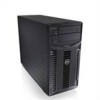Dell PowerEdge T410 Hardware Owner's Manual - Page 106
System Memory, General Memory Module Installation Guidelines - quad rank memory mhz
 |
View all Dell PowerEdge T410 manuals
Add to My Manuals
Save this manual to your list of manuals |
Page 106 highlights
System Memory Your system supports DDR3 registered memory modules (RDIMMs) or ECC unbuffered memory modules (UDIMMs). Single and dual-rank memory modules can be 1067- or 1333-MHz, and quad-rank memory modules can be 1067-MHz. The system contains eight memory sockets split into two sets of four sockets, one set per each processor. Each four-socket set is organized into two DIMMs for channel 0 and a single DIMM for channel 1 and channel 2. The first socket of each channel is marked with white release levers. The maximum memory that is supported on your system varies according to the types and sizes of memory modules being used: • Single-rank and dual-rank RDIMMs of sizes 2-GB, 4-GB, and 8-GB (when available) are supported for a total of up to 64 GB. • Quad-rank RDIMMs are supported for a total of up to 64 GB. • 1-GB and 2-GB UDIMMs are supported for a total of up to 16 GB. General Memory Module Installation Guidelines To ensure optimal performance of your system, observe the following general guidelines when configuring your system memory. NOTE: Memory configurations that fail to observe these guidelines can prevent your system from starting or producing any video output. • RDIMMs and UDIMMs cannot be mixed. • Except for memory channels that are unused, all populated memory channels must have identical configurations. • In a dual-processor configuration, the memory configuration for each processor must be identical. • Memory modules of different sizes can be mixed within a memory channel (for example, 2-GB and 4-GB), but all populated channels must have identical configurations. This applies to only channel 0. • For Optimizer Mode, memory modules are installed in the numeric order of the sockets beginning with A1 or B1. 106 Installing System Components















